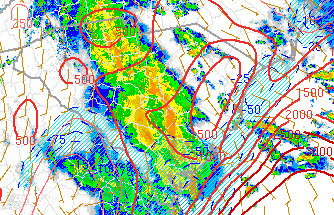
CAPE stands for Convective Available Potential Energy. This value is used to indicate how strong updrafts will be if convective storms develop. A guide to CAPE values is below. When CAPE is present, most of the time it will be from 1-1,500 and will produce weak to moderate updrafts. Storms can be more severe as the CAPE value increases further. 1-1,500: Positive CAPE 1,500 – 2,500: Large CAPE 2,500+: Extreme CAPE Convective Inhibition (CIN) is the energy that needs to be overcome in order for convection to occur. Another term for this is a cap or lid. A lifting mechanism will need to overcome this inhibition in order for surface based storms to occur. This inhibition can be weakened by daytime heating, frontal lifting, low level convergence, storm generated outflow, upper level divergence and other lifting mechanisms. Once the inhibition is overcome, then CAPE will take over and help control the updraft intensity. A guide to convective inhibition values is below: 0-50: Weak Inhibition 51-199: Moderate Inhibition 200+: Strong Inhibition The example below is an example of the interplay between CAPE and Inhibition. Storms have already developed which means the lifting has overcome the inhibition and CAPE is available to generate storms. Where the storms have not formed or moved to yet, there is some inhibition. The values are weak since the convective inhibition is 50 and less (hatched blue region). Storm outflow boundaries are effective lifting mechanisms. It can be expected that any remaining inhibition will easily be overcome as the storms propagate toward the east. The CAPE values (red numbers) are high out ahead of the storms. Notice the 1,500+ CAPE values out ahead of the storms. It can be expected these storms will have very strong updrafts as the region of storms moves toward and develops toward the east. Strong updrafts can lead to the generation of severe hail and severe convective wind gusts through the resulting downdrafts.  |